
Did you know that California is home to over 6,000 native plants? While many of us are familiar with the redwoods and other iconic trees, there are a number of lesser-known natives that deserve our attention. Let’s take a closer look at some of our favorites!
1. Toyon (Heteromeles arbutifolia)
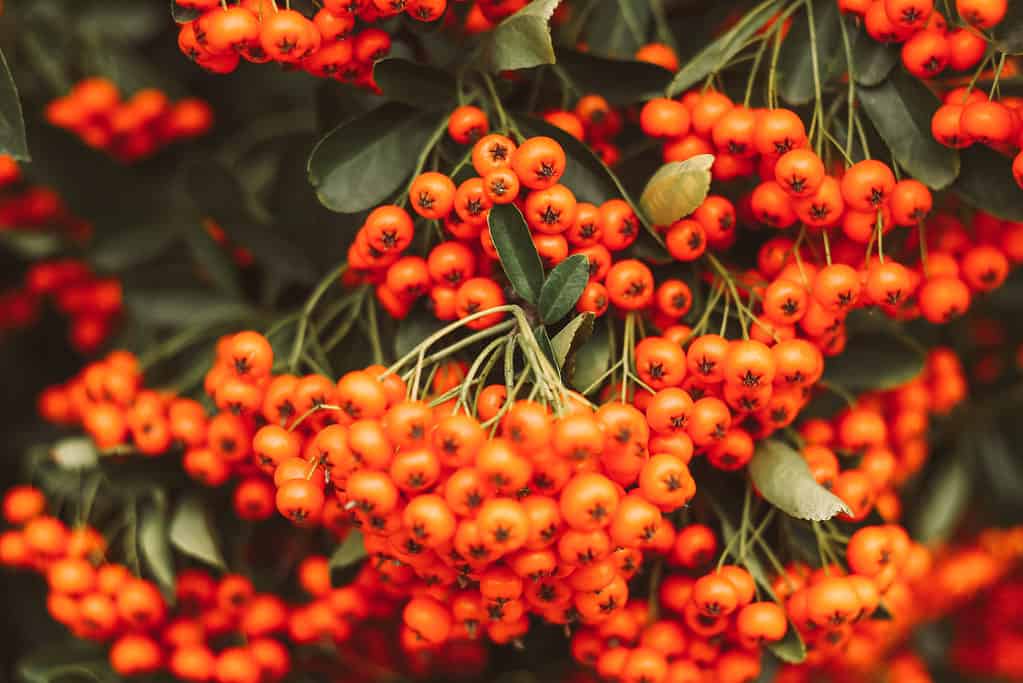
Toyon produces fragrant white flowers in early summer, followed by small red berries later in the season that attracts wildlife such as birds, deer, and other animals.
©ElenM/Shutterstock.com
Toyon, also known as Heteromeles Arbutifolia, is an evergreen shrub native to California. It is a member of the plant family Rosaceae, which includes many well-known plants, such as roses and apples.
Known by many names, including Christmas berry and California holly, Toyon produces fragrant white flowers in early summer, followed by small red berries later in the season that attracts wildlife such as birds, deer, and other animals.
The deep green leaves are waxy and leathery. Long-lived and drought tolerant, Toyon is low maintenance and grows best in sunny sites with well-drained soil where its unique form can provide natural beauty both in gardens or open fields. It is also beneficial for honey bees as it provides nectar for pollination during its floral bloom period.
Since it is an evergreen plant, its leaves provide year-round shelter to many different kinds of birds and other wildlife.
2. California Poppy (Eschscholzia californica)

The California poppy has a sedative effect when consumed, and it was traditionally used to treat various ailments, such as insomnia and pain.
©alybaba/Shutterstock.com
The California poppy is a sight to behold, with its bright petals that can range in colors from deep oranges and reds to cheerful yellow. Part of the reason these flowers are so striking is their distinct shape – the four petals scatter outward from the center, leading to a fairly large bloom four or five inches wide.
Not only do these blooms look good, but they also smell great, often emitting an aroma sweet enough to reach even the most sensitive noses! Don’t forget the California Poppy is also the official state flower of California.
Their drought tolerance and low maintenance factor make these flowers ideal for sunny summer days or dry desert landscapes.
One interesting fact about the California Poppy is that it has been used medicinally by Native Americans for centuries. The plant has a sedative effect when consumed, and it was traditionally used to treat various ailments, such as insomnia and pain. However, it is important to note that the California Poppy can be toxic if consumed in large quantities, so it should be used cautiously.
So whether you’re adding this beautiful plant to your garden or going on a hike to take in its loveliness in the wild, the California Poppy will surely add some color to your life!
3. Chuparosa (Justicia californica)
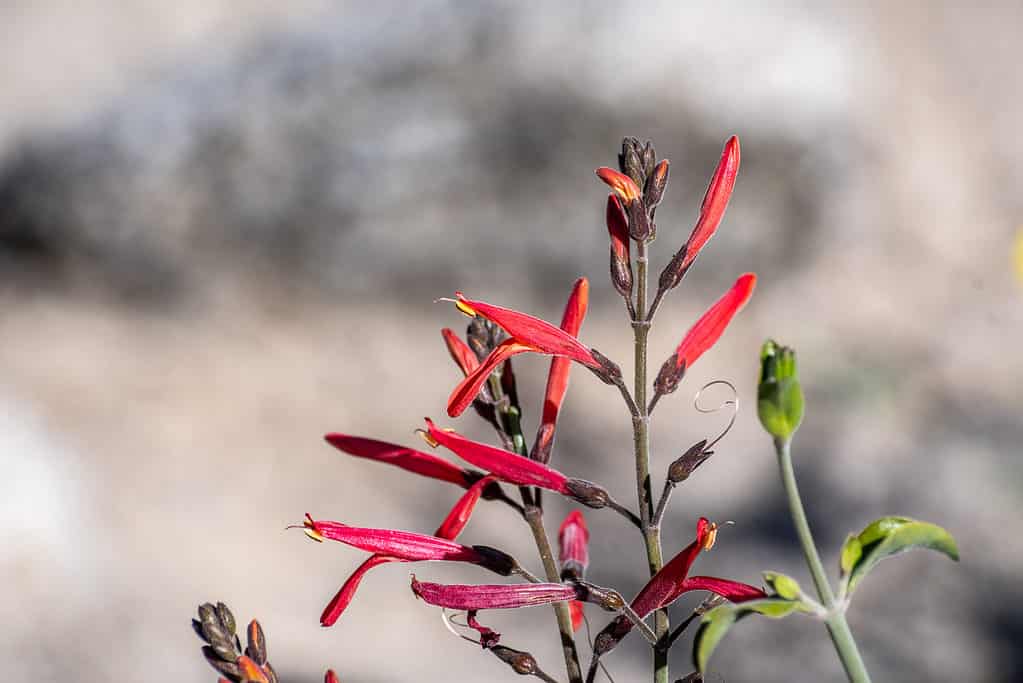
Chuparosa is a versatile shrub that can be used in various settings, including gardens, natural landscapes, and even urban areas.
©Sundry Photography/Shutterstock.com
Chuparosa, or Justicia Californica as it is properly known, is a perennial shrub native to California that adds bold color and vibrancy to any garden space. With commonly bright red flowers that last from March until the first frost, this charming and decorative shrubby bush will bring life and attract interest from everyone.
Chuparosa is a versatile shrub that can be used in various settings, including gardens, natural landscapes, and even urban areas. Not only are its gorgeous petals incredibly strong, but Chuparosa is also drought tolerant – making for an ideal long-term choice for gardens in hot climates.
Commonly referred to as hummingbird trumpet or hummingbird sage, this wildflower has a red or yellow bell-shaped flower that vaguely resembles a miniature azalea. Growing best in drier mountainous climates, Chuparosa can be seen climbing roadsides and occasionally adorning rock walls around the western United States.
One interesting fact about the plant is that the word “chuparosa” means hummingbird in Spanish!
4. Golden Lupine (Lupinus microcarpus Var. densiflorus)

Golden lupine is also a valuable food source for pollinators such as bees and butterflies, making it a valuable addition to any garden.
©Michael Vi/Shutterstock.com
Golden lupine, also called whitewhorl or dense-flowered lupine, is one of the most beautiful-looking flowers native to the western parts of the United States. This plant’s contrasting yellow and green colors make it stand out in any garden or landscape. It grows well in clay and loamy soils that are highly alkaline in nature, and its drought-tolerant quality makes it an ideal flower for tough conditions.
It boasts bright yellow petals with black eye spots and has a rich, vibrant scent. Although it doesn’t grow very high (around 3 feet), these tiny flowers have beautiful linear leaves and can spread quickly if given the proper conditions to thrive. Its hardy nature means it can often be found blooming in barren fields, chaparral areas, and grasslands.
Golden lupine is also a valuable food source for pollinators such as bees and butterflies, making it a valuable addition to any garden.
With a hardy nature and eye-catching features, it’s no surprise that this species of lupines has become a favorite among landscaping enthusiasts!
5. Manzanita (Arctostaphylos)
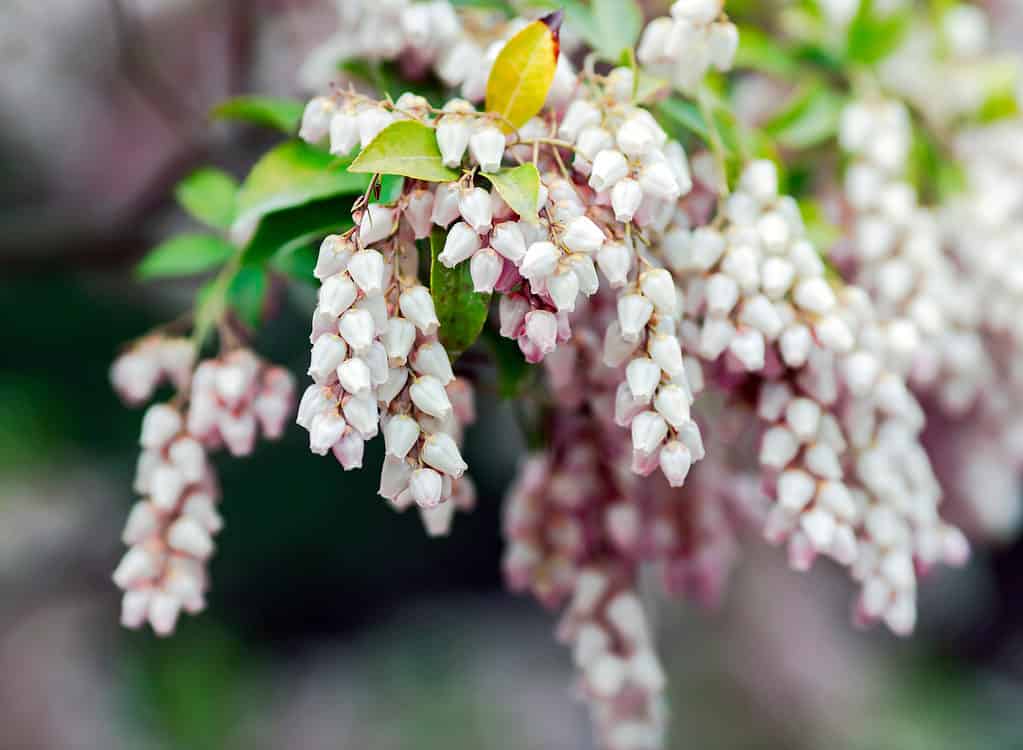
The word “manzanita” means “little apple” in Spanish, and Native Americans traditionally used its fruits as a food source.
©Tanya Keisha/Shutterstock.com
Manzanita, also known as Arctostaphylos, is one of the most widely varied and remarkable plant species. Found throughout the state of California, manzanita is found mostly in arid and semi-arid woodlands and scrubland habitats.
Its unique oval leaves are glossy and distinctly veined. It produces clusters of bell-shaped blooms that can range from white to light pink. Manzanita can grow up to 15 feet tall with a grayish bark that is often smooth like velvet.
The berries it bears are small but sweet, making them popular with birds and other wildlife. Above all, its fire-resistant properties have also made it a desirable choice for landscaping near structures like homes or campsites.
Although they are a drought-tolerant species that require very little maintenance, occasional pruning to the desired shape can enhance their unique appearance.
The word “manzanita” means “little apple” in Spanish, and Native Americans traditionally used its fruits as a food source. Whether you choose to grow it yourself or just admire its natural beauty while hiking, the manzanita is sure to become your favorite evergreen shrub!
6. Coffeeberry (Frangula californica)
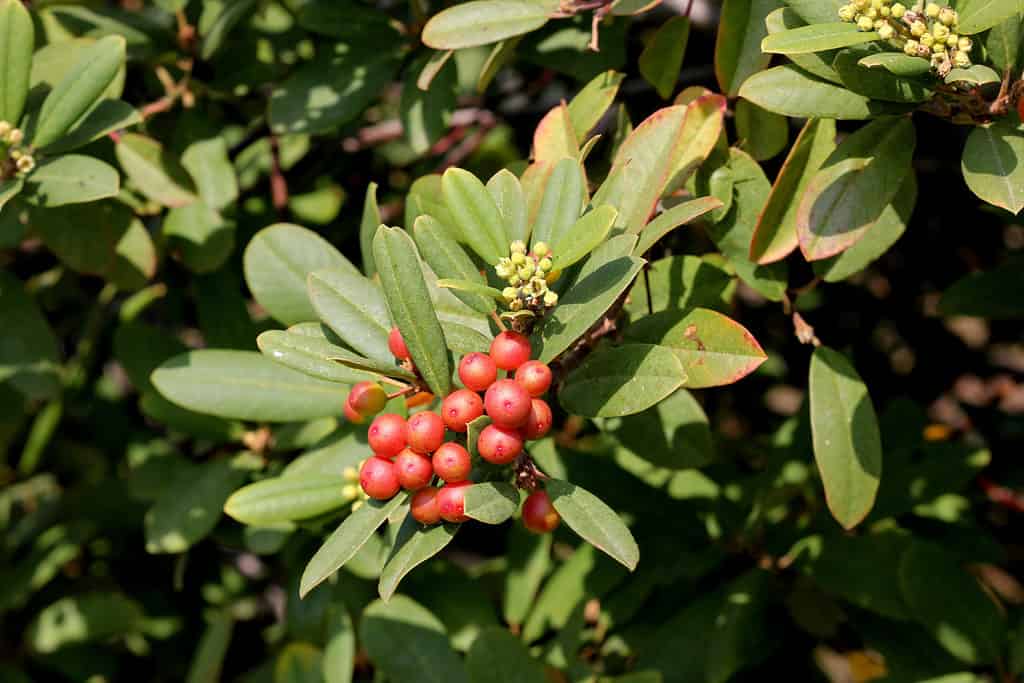
Coffeeberries have glossy dark green leaves and berries that form on the bushes throughout the winter season.
©Gurcharan Singh/Shutterstock.com
If you’re looking for a unique and interesting addition to your garden, look no further than the coffeeberry, otherwise known as Frangula Californica. Native to California, this evergreen shrub produces an abundance of clusters of green, red, or black berries that not only look beautiful but can be used to make a delicious tea as well.
In fact, the leaf of the coffeeberry plant is said to contain potent anti-oxidants which can help boost immunity with its anti-inflammatory properties. Also, this berry was an important food source for local tribal communities thousands of years before European arrival on the west coast.
Coffeeberries have glossy dark green leaves and berries that form on the bushes throughout the winter season. This hardy shrub is often seen sprouting up anywhere from sea level to around 6,000 feet in elevation. Additionally, this plant can grow anywhere between 6 to 15 feet tall, depending on conditions.
Nowadays, the coffeeberry has gained recognition for its various antioxidant properties used in the skincare industry thanks to research exploring its antiaging effects. Plus, it’s easy to grow and will thrive no matter what kind of soil you have in your garden. Get yourself a coffeeberry shrub – you won’t be disappointed!
7. California Sagebrush (Artemisia californica)

The California sagebrush is a common sight in many parts of California, where it grows in chaparral, grassland, and coastal scrub habitats.
©Anne Kitzman/Shutterstock.com
California sagebrush is a beautiful and aromatic crown of the California chaparral and woodlands. It gives a subtle earthy scent to the air that lingers with each gust of wind. All parts of this shrub are dotted with an array of greyish-green leaves, all attached to many slender stems, which, when combined, make this species an undeniable standout.
The yellowish flowers that appear in the spring give off a striking contrast against the backdrop of the evergreen plant. But the plant is known to produce some red flowers as well. While drought-tolerant and hardy, the California sagebrush requires regular watering during dry spells. When given proper care, these lovely shrubs can reach up to 6 feet wide and 8 feet tall.
In traditional medicine, the California sagebrush has been used by Native American tribes to treat various ailments. It’s been used as a digestive aid, as well as a cold and cough remedy. Some tribes have also used it ceremonially, burning it to produce fragrant smoke.
The California sagebrush is a common sight in many parts of California, where it grows in chaparral, grassland, and coastal scrub habitats. It’s often used in landscaping and gardening, and it’s prized for its ability to attract various birds and other wildlife.
Whether planted in full sun or partial shade, these resilient plants make a great sustainable addition to any yard!
8. Coastal Prickly Pear (Opuntia littoralis)
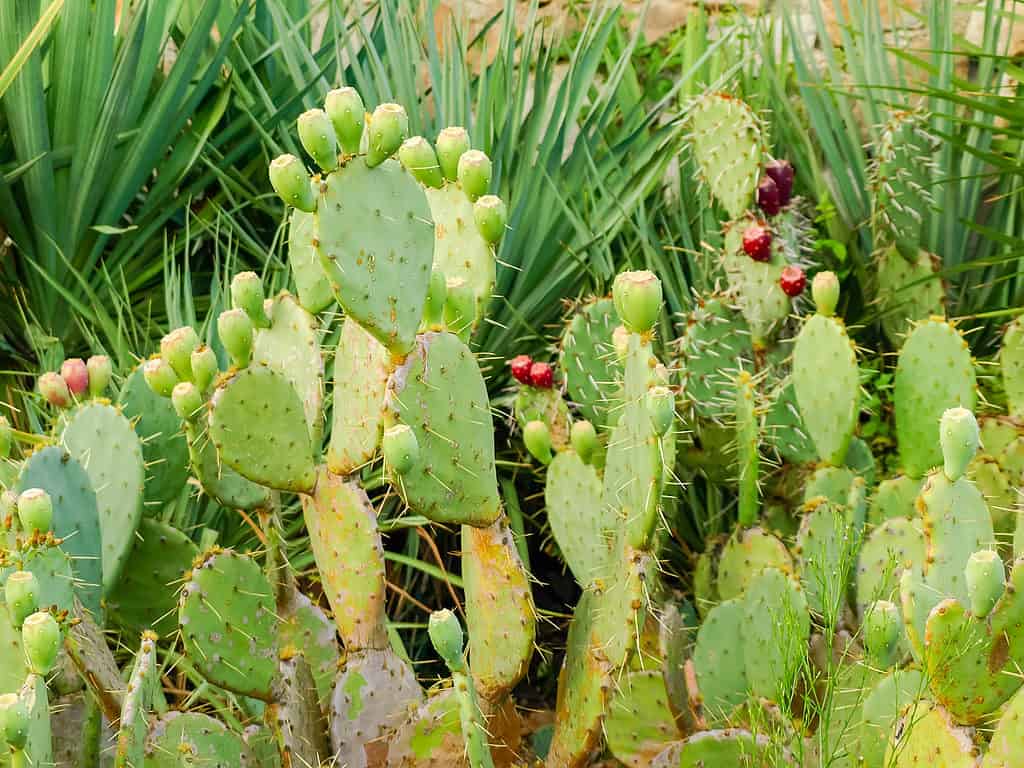
In addition to its durability, the coastal prickly pear is also valued for its colorful fruit, which can be eaten fresh or used in many different dishes.
©anmbph/Shutterstock.com
Coastal prickly pear, also known as Opuntia littoralis, is a species of cactus that is native to the coastal regions of California and the Pacific Northwest. It’s a member of the prickly pear cactus family, and it’s known for its flat, oval-shaped pads and its colorful, edible fruit.
With its thick, waxy coating which covers its leaves, this succulent can endure salted winds and turbulent weather conditions.
One of the most recognizable features of this unusual plant is its thin green stems – each tipped with an impressive armory of spines! So, be careful when handling this plant.
In addition to its durability, the coastal prickly pear is also valued for its colorful fruit, which can be eaten fresh or used in many different dishes. The fruit has a sweet, juicy flavor and a unique, slightly tangy taste. It’s also a good source of vitamins and minerals, making it a healthy and tasty addition to any diet.
Overall, the coastal prickly pear is a hardy and attractive plant that can add interest to any garden. Its ability to tolerate harsh coastal conditions makes it a valuable plant for coastal gardens. It is low maintenance and grows up to 1-2 feet. The only thing you need to care about is the roots getting too damp; if that happens, this beautiful cactus may rot.
9. Mountain Violet (Viola purpurea)
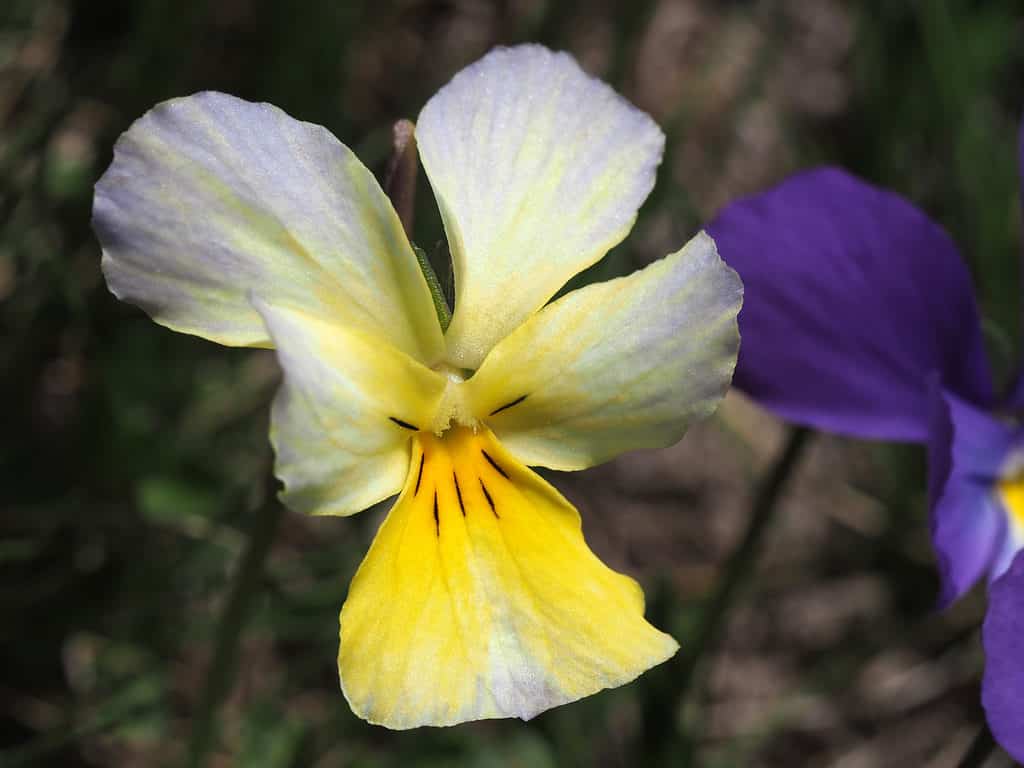
This delicate wildflower flourishes in spring, favoring rocky and alpine soil as its natural habitat.
©Roberto Rulli/Shutterstock.com
Mountain violets, also called goosefoot violets, are one of nature’s loveliest wildflowers. Found in the mountainous regions of California, these delicate yellow petals with purple undertones have captured the hearts of many. Though small, their impact is immense, and they add a burst of color to the leafy, evergreen forests and grassy slopes surrounding them.
This delicate wildflower flourishes in spring, favoring rocky and alpine soil as its natural habitat. Unlike many other flowers, this alluring violet blooms in cooler climates and, despite its small size, provides a stunning visual impact with its bright yellow petals.
So, if you live in an area where mountain violet grows naturally, consider adding it to your garden to help support local wildlife and add a touch of beauty to your landscape.
Summary of 9 Native Plants in California
Here is a summary of 9 Native Plants in California:
| Rank | Native Plants |
|---|---|
| 1 | Toyon (Heteromeles arbutifolia) |
| 2 | California Poppy (Eschscholzia californica) |
| 3 | Chuparosa (Justicia californica) |
| 4 | Golden Lupine (Lupinus microcarpus Var. densiflorus) |
| 5 | Manzanita (Arctostaphylos) |
| 6 | Coffeeberry (Frangula californica) |
| 7 | California Sagebrush (Artemisia californica) |
| 8 | Coastal Prickly Pear (Opuntia littoralis) |
| 9 | Mountain Violet (Viola purpurea) |
The photo featured at the top of this post is © Anne Kitzman/Shutterstock.com
Sources
- YouTube, Available here: https://www.youtube.com/watch?v=hdARi5_Sboc
- LawnStarter, Available here: https://www.lawnstarter.com/blog/california/native-plants-california/
- GARDEN DESIGN, Available here: https://www.gardendesign.com/california/native-plants.html
- Green Acres Nursery & Supply, Available here: https://idiggreenacres.com/collections/california-native-plants
- Los Angeles County Arboretum and Botanic Garden, Available here: https://www.arboretum.org/crescentfarm/grow/california-native-plants-list/
Thank you for reading! Have some feedback for us? Contact the AZ Animals editorial team.






